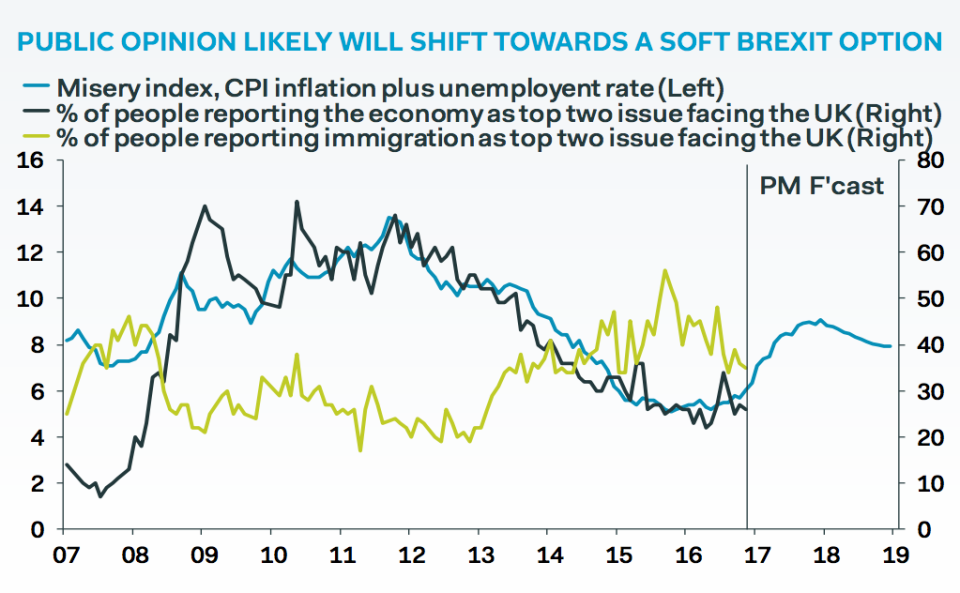The pound is actually going to have a great 2017

REUTERS/Ahmad Masood
LONDON — After a few weeks of relative calm, the pound is back to its post-Brexit vote routine on Monday, falling sharply after Prime Minister Theresa May all but confirmed that she is aiming for a "Hard Brexit" — Britain leaving the European Single Market in order to regain immigration and boarder control.
However, according to new research from Pantheon Macroeconomics, the pound should actually end up enjoying a pretty strong year, rising by as much as 7% on the dollar from Monday's lows.
That is thanks to what Pantheon calls the "underpriced" potential for Britain to end up with a soft Brexit deal.
Pantheon's basic argument is that as the impending post-vote economic impacts of the vote — mainly inflation and rising unemployment — start to bite, the public will no longer see immigration as the UK's biggest problem. "The health of the economy soon will replace immigration as the public’s main concern," Pantheon's Samuel Tombs writes.
That will then push the government away from a "hard Brexit," and toward a softer approach.
Pantheon has the chart to prove it, saying: "Our next chart shows the close past relationship between the “misery index”—the sum of the rates of inflation and unemployment—and the proportion of people who think the economy is one of the two most important issues facing the country."
Here is that chart:

REUTERS/Ahmad Masood
If economics starts to dominate the public discourse as Brexit negotiations progress, the government will have to shift its focus, Tombs argues:
"Plugging in our forecasts for the unemployment rate to edge up and CPI inflation to rise to a peak of 3.5% by the end of 2017 suggests that the Government will be under pressure to implement the least economically damaging Brexit option possible."
As "soft Brexit" becomes a more likely option, the pound will likely recover, with investors taking a little comfort from the dwindling prospect of the UK severing ties with the other 27 members of the EU completely.
All of this means that sterling could end the year up around 7% on the dollar at $1.30, and by a similar margin against the euro to end 2017 at €1.24.Tombs concludes (emphasis ours):
"We continue to think that the chance of a soft Brexit is underpriced. The recovery path for sterling likely will not be smooth, nor do we expect the risk premium to disappear entirely this year. A Brexit deal will not be circulated to E.U. member states for approval until October 2018, at the earliest. But we think further signs that the Government is being forced towards a soft Brexit will emerge, enabling sterling to climb back to about $1.30 and €1.24 by the end of this year."
NOW WATCH: How Donald Trump used bankruptcy to stay rich
See Also:
SEE ALSO: DEUTSCHE BANK: The pound only has one way to go — down
DON'T MISS: A new survey shows Brexit has fundamentally changed how we think about the pound
UP NEXT: The pound is at a 3-month low against the dollar after Theresa May's 'Hard Brexit rhetoric'

 Yahoo Finance
Yahoo Finance 
